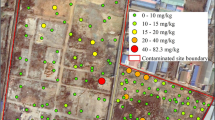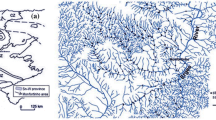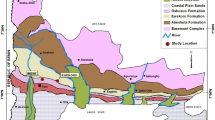Abstract
The identification of contamination “hotspots” are an important indicator of the degree of contamination in localized areas, which can contribute towards the re-sampling and remedial strategies used in the seriously contaminated areas. Accordingly, 114 surface samples, collected from an industrially contaminated site in northern China, were assessed for 16 polycyclic aromatic hydrocarbons (PAHs) and were analyzed using multivariate statistical and spatial autocorrelation techniques. The results showed that the PCA leads to a reduction in the initial dimension of the dataset to two components, dominated by Chr, Bbf&Bkf, Inp, Daa, Bgp, and Nap were good representations of the 16 original PAHs; Global Moran’s I statistics indicated that the significant autocorrelations were detected and the autocorrelation distances of six indicator PAHs were 750, 850, 1,200, 850, 750, and 1,200 m, respectively; there were visible high–high values (hotspots) clustered in the mid-bottom part of the site through the Local Moran’s I index analysis. Hotspot identification and spatial distribution results can play a key role in contaminated site investigation and management.



Similar content being viewed by others
Abbreviations
- PAH:
-
Polycyclic aromatic hydrocarbon
- Nap:
-
Naphthalene
- Acy:
-
Acenaphthylene
- Ace:
-
Acenaphthene
- Fle:
-
Fluorine
- Phe:
-
Phenanthrene
- Ant:
-
Anthracene
- Fla:
-
Fluoranthene
- Pyr:
-
Pyrene
- Baa:
-
Benzo(a)anthracene
- Chr:
-
Chrysene
- Bbf&Bkf:
-
Benzo(b,k)fluoranthene
- Bap:
-
Benzo(a)pyrene
- Daa:
-
Dibenzo(a,h)anthracene
- Bgp:
-
Benzo(g,h,i)perylene
- Inp:
-
Indeno(1,2,3-c,d)pyrene
- PCA:
-
Principal component analysis
References
Barreto-Neto, A. A., & Silva, A. B. D. S. (2004). Methodological criteria for auditing geochemical data sets aimed at selecting anomalous lead–zinc–silver areas using geographical information systems. Journal of Geochemical Exploration, 84(2), 93–101.
Blake, W. H., Walsh, R. P., Reed, J. M., Barnsley, M. J., & Smith, J. (2007). Impacts of landscape remediation on the heavy metal pollution dynamics of a lake surrounded by non-ferrous smelter waste. Environmental Pollution, 148(1), 268–280.
Bohórquez, L., Gómez, I., & Santa, F. (2011). Methodology for the discrimination of areas affected by forest fires using satellite images and spatial statistics. Procedia Environmental Sciences, 7, 389–394.
Brody, S. D., Highfield, W. E., & Thornton, S. (2006). Planning at the urban fringe: an examination of the factors influencing nonconforming development patterns in southern Florida. Environment and Planning B: Planning and Design, 33(1), 75–96.
Carson, J. H. (2001). Analysis of composite sampling data using the principle of maximum entropy. Environmental and Ecological Statistics, 8(3), 201–211.
Castillo, K. C., Körbl, B., Stewart, A., Gonzalez, J. F., & Ponce, F. (2011). Application of spatial analysis to the examination of dengue fever in Guayaquil, Ecuador. Procedia Environmental Sciences, 7, 188–193.
Cliff, A. D., & Ord, J. K. (1981). Spatial processes: models and applications. London: Pion.
Cressie, N. (1991). Statistics for spatial data. New York: Wiley.
Epperson, B. K. (2003). Covariances among join-count spatial autocorrelation measures. Theoretical Population Biology, 64(1), 81–87.
Getis, A., & Ord, J. K. (1996). Local spatial statistics: an overview. In P. Longley & M. Batty (Eds.), Spatial analysis: modelling in a GIS Environment. Cambridge: GeoInformation International.
Grimalt, J. O., van Drooge, B. L., Ribes, A., Fernández, P., & Appleby, P. (2004). Polycyclic aromatic hydrocarbon composition in soils and sediments of high altitude lakes. Environmental Pollution, 131, 13–24.
Huo, X. N., Li, H., Sun, D. F., Zhou, L. D., & Li, B. G. (2012). Combining geostatistics with Moran’s I analysis for map** soil heavy metals in Bei**g, China. International Journal of Environmental Research and Public Health, 9(3), 995–1017.
**g, N., & Cai, W. X. (2010). Analysis on the spatial distribution of logistics industry in the developed East Coast Area in China. The Annals of Regional Science, 45(2), 331–350.
Kabos, S., & Csillag, F. (2002). The analysis of spatial association on a regular lattice by join-count statistics without the assumption of first-order homogeneity. Computers & Geosciences, 28(8), 901–910.
Komnitsas, K., & Modis, K. (2009). Geostatistical risk estimation at waste disposal sites in the presence of hot spots. Journal of Hazardous Materials, 164(2–3), 1185–1190.
Kulldorff, M. (1997). A spatial scan statistic. Commun. Statist. Theory Methods, 26(6), 1481–1496.
Lai, D. J. (2009). Testing spatial randomness based on empirical distribution function: A study on lattice data. Journal of Statistical Planning and Inference, 139(2), 136–142.
Luo, Q., Catney, P., & Lerner, D. (2009). Risk-based management of contaminated land in the UK: lessons for China? Journal of Environmental Management, 90(2), 1123–1134.
Mostert, M. M. R., Ayoko, G. A., & Kokot, S. (2012). Multi-criteria ranking and source identification of metals in public playgrounds in Queensland, Australia. Geoderma, 173–174, 173–183.
Patil, G. P., & Taillie, C. (2001). Use of best linear unbiased prediction for hot spot identification in two-way compositing. Environmental and Ecological Statistics, 8(2), 163–169.
Prasannakumar, V., Vijith, H., Charutha, R., & Geeth, N. (2011). Spatio-temporal clustering of road accidents: GIS based analysis and assessment. Procedia - Social and Behavioral Sciences, 21, 317–325.
Sinha, P., Lambert, M. B., & Schew, W. A. (2007). Evaluation of a risk-based environmental hot spot delineation algorithm. Journal of Hazardous Materials, 149(2), 338–345.
Su, S. L., Jiang, Z. L., Zhang, Q., & Zhang, Y. (2011). Transformation of agricultural landscapes under rapid urbanization: a threat to sustainability in Hang-Jia-Hu region, China. Applied Geography, 31(2), 439–449.
Tiefelsdorf, M., & Boots, B. (1997). A note on the extremities of Local Moran’s I is and their impact on Global Moran’s I. Geographical Analysis, 29(3), 248–257.
USEPA. SW-846 method 8270D. (2007a). Semivolatile organic compounds by gas chromatography/mass spectrometry (GC/MS). http://www.epa.gov/osw/hazard/testmethods/sw846/pdfs/8270d.pdf. Accessed February 2007.
USEPA. SW-846 method 8272. (2007b). Parent and alky polycyclic aromatic in sediment pore water by solid -phase microextraction and gas chromatography/mass spectrometry in selected ion monitoring mode. http://www.epa.gov/osw/hazard/testmethods/pdfs/8272.pdf. Accessed December 2007.
Wang, J., Zhu, L. Z., & Shen, X. Y. (2003). PAHs pollution in air of coke plant and health risk assessment. Environment Science, 24(1), 135–138 (in Chinese).
Wang, J. G., Zhan, X. H., Zhou, L. X., & Lin, Y. S. (2010). Biological indicators capable of assessing thermal treatment efficiency of hydrocarbon mixture-contaminated soil. Chemosphere, 80(8), 837–844.
Wang, F. S., **ng, S. L., & Huo, X. R. (2012). Study on the distribution pattern of PAHs in the coking dust from the coking environment. Procedia Engineering, 45, 959–961.
Zhang, C. S., & McGrath, D. (2004). Geostatistical and GIS analyses on soil organic carbon concentrations in grassland of southeastern Ireland from two different periods. Geoderma, 119(3–4), 261–75.
Zhang, C. S., Luo, L., Xu, W. L., & Ledwith, V. (2008). Use of local Moran’s I and GIS to identify pollution hotspots of Pb in urban soils of Galway, Ireland. Science of the Total Environment, 398(1–3), 212–221.
Acknowledgments
This research was supported by the Environmental Protection Public Welfare Research Funds (grant no. 201009015) and Young Scientists Fund of NSFC (grant no. 40901249).
Author information
Authors and Affiliations
Corresponding author
Rights and permissions
About this article
Cite this article
Liu, G., Bi, R., Wang, S. et al. The use of spatial autocorrelation analysis to identify PAHs pollution hotspots at an industrially contaminated site. Environ Monit Assess 185, 9549–9558 (2013). https://doi.org/10.1007/s10661-013-3272-6
Received:
Accepted:
Published:
Issue Date:
DOI: https://doi.org/10.1007/s10661-013-3272-6




